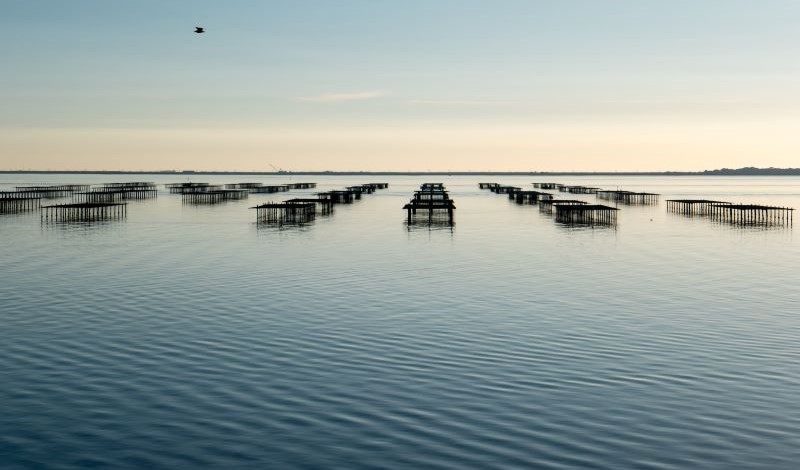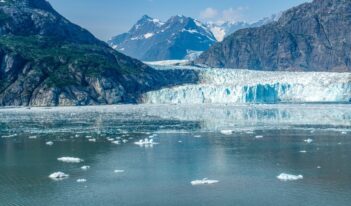
Scholar explores how kelp and shellfish farms can support U.S. climate goals.
Marine aquaculture is not just a source of food—it can also sequester carbon, improve water quality, and restore marine ecosystems.
These capabilities, observes Robin Craig, professor and trustee chair at the University of Southern California Gould School of Law, make the marine aquaculture industry valuable not just for food security, but for climate change adaptation and mitigation. Regulators should streamline existing regulatory processes to promote the collateral benefits of marine aquaculture, Craig argues.
The United Nations reported that the world has made “inadequate progress” toward Paris Agreement climate goals. The institution asserted the need for “system-wide transformation” across “electricity supply, industry, transport and buildings sectors, and the food and financial systems.” Craig observes, however, that “ancillary” sectors, such as insurance, artificial intelligence, and food production “are unlikely to inspire new legislative programs and incentives” in the same way that renewable energy has, despite these sectors potential to support climate strategy.
Craig explores marine aquaculture as one such industry and argues that certain species, namely kelp and shellfish, deserve differentiated treatment by regulators due to the low, if not positive, environmental impact of their cultivation.
In the United States marine farmers cultivate a variety of species, and the ecological effects of each can vary. On the one hand, Atlantic salmon farming, for example, represents the largest share of U.S. marine aquaculture. The practice, however, is fraught with environmental risks, such as nutrient pollution and biodiversity loss, Craig notes.
On the other hand, kelp, she cites, can reduce nutrient pollution, sequester carbon dioxide, serve as a buffer from the effects of high ocean acidity, and provide oxygen-rich habitats to allow other species to thrive. Shellfish, such as oysters, can also mitigate nitrogen pollution.
Furthemore, rising ocean temperatures shift the geographic range of certain marine species, impacting the livlihoods of fishing communities. Craig highlights that marine aquaculture can help these communities adapt to these shifts by offering a more stable alternative form of seafood production. Shellfish and kelp, Craig concludes, may offer both food security and collateral benefits that support climate mitigation and adaption.
The federal agencies who regulate mariculture are just beginning to recognize the industry’s potential environmental benefits and use toward achieving United States climate goals, Craig observes. She argues that the agencies should assert greater recognition of these benefits and their discretion to shape regulatory processes that prefer and promote marine kelp and shellfish aquaculture.
Craig identifies that the complex permitting process required for marine aquaculture operations is the “the greatest impediment to industry expansion.” Indeed, mariculture projects must fulfill permit, license, and lease requirements at federal, state, and tribal level. The Trump Administration, however, issued an executive order in 2020 that provides an opportunity to streamline the federal permitting process for preferential forms of aquaculture, Craig notes.
The executive order directed the Secretary of Commerce, through the National Oceanic and Atmospheric Administration (NOAA), to designate of Acquaculture Opportunity Areas, that may be “environmentally, socially, and environmenally” suitable. Operators who seek to establish projects in designated areas, however, must still complete all applicable federal and state permitting processes and environmental reviews.
Craig urges NOAA to integrate representatives of relevant federal, state, and tribal agencies into the opportunity area designation process and thereby establish a consensus of designation criteria that align with both the federal and local permitting and review processes. This approach, Craig argues, could help consolidate and expedite approvals of new aquaculture.
The order also tasked the U.S. Army Corps of Engineers to develop general, nationwide aquaculture permits. The Army Corps may issue general permits for particular activities that have a minimal negative impact on the environment. These general permits streamline the project approval process by granting federal permission for a specific activity on a national basis, as opposed to an individual permit issued on a case-by-case basis.
In response to the order, Craig observes that the Army Corps issued national permits for the mariculture shellfish, seaweed, and finfish. She urges the Army Corps to continue issuance of differentiated general mariculture permits and to consider the issuance of regional permits. Through a regional permit approach, Craig suggests, the Army Corps, like NOAA, could tailor permit criteria to local permitting and environmental requirements to add efficiencies to the overall project approval process.
The Trump Administration however, did not issue the executive order to promote the climate benefits of aquaculture, Craig notes. She therefore encourages NOAA and the Army Corps to use their discretion to tailor opportunity area designation and general permit criteria to prefer sites amenable to climate-friendly species like kelp and shellfish.
Craig argues that under this approach regulators can maximize the potential of marine aquaculture “to simultaneously improve domestic food security, provide economic opportunity, improve marine water quality and ecosystems, and contribute to climate change mitigation and adaptation goals.”
Marine aquaculture is just one of many other regulated industries that offer co-benefits in favor of United States climate strategy, Craig observes. She challenges the administrative state to “evaluate these industries through a climate change lens” and exercise discretion to “harness the climate change advantages these industries offer.”



